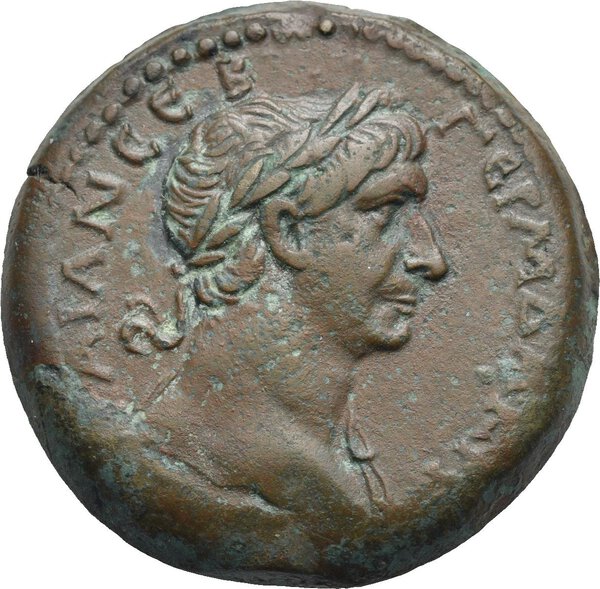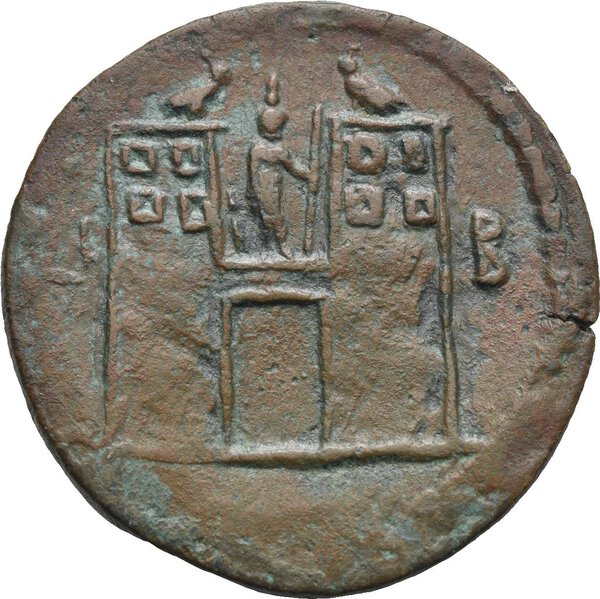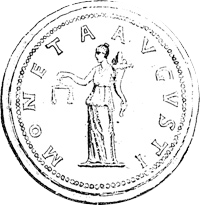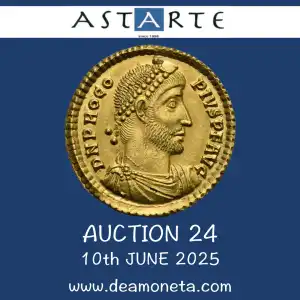





Egypt. Alexandria. Trajan, AD 98-117. Drachm (Bronze, 34.65 mm, 24.85 g). Dated RY 12 = AD 108/9. [ΑΥΤ TP] AIAN CEB ΓEPM ΔAKIK Laureate, draped and cuirassed bust of Trajan right, partially seen from behind. Rev. Anepigraph; in the centre, temple facade in Egyptian form with two lateral pylons each equipped with four windows and linked each other by the entrance portal upon which is standing, facing the pharaonic deity Horus dressed with the ritual tunic and pshent crown on head. She has in her left hand the onas sceptre and right arm stretched out at her side; at her feet on the left, a small animated image facing (Harpokrates). Two hawks wearing pshent crown on head are perched on top of the pylons; L I B (date) across fields. Vogt I, pp.70-78. Vogt II, p. 29. Dattari-Savio, plate 59, 1161 (this coin). RPC III 4330.2.4 (this coin). Emmett 521 (illustrated p. 33). Staffieri G. M., "Il tempio di Horus a Edfu nella monetazione alessandrina" in "Quaderni Ticinesi di Numismatica e Antichità Classiche" (NAC), XLVII, 2018, pp. 237-249. Extremely rare and probably the best specimen known. Very nice portrait. Attractive brown patina. About Extremely Fine and of great monumental importance.
From the Dattari Collection. Illustrated in Dattari. Ex Naville Numismatics Ltd. 39, 29.04.2018, lot 332.
Coin of fundamental iconographic interest and of absolute rarity attends its improper position described in RPC III 4530.3 as well as, despite the correct description, the incorrect attribution in RPC III 4330.1 of the items Dattari 1160-1161-1162. The importance of the drachm lies in the reverse where the Egyptian temple represented is impressively similar to that of specimen 1161 illustrated in my essay on NAC 2018 cited above and clearly identified in the Hellenistic temple of Horus in Edfu where the relative recognition, in comparing the coins with the existing original monument, it was facilitated not only by the series of four windows being on each tower of the pylon of the facade and the pair of Horus-falcons facing each other on the roofs of the towers (all elements also present here), but also by the anthropomorphic figure of the canonical Horus depicted above the portal between the two towers, flanked at his feet by the image of the falcon, his alter ego. In our case the figure is intentionally replaced by that of his mythical mother according to Egyptian theogony, i.e. Isis, flanked at the feet et pour cause, by Harpokrates, the child Horus. How can we not therefore deduce from these explicit and convincing clues that this too is a representation of the temple of Horus in Edfu, on whose walls Isis is repeatedly depicted?


